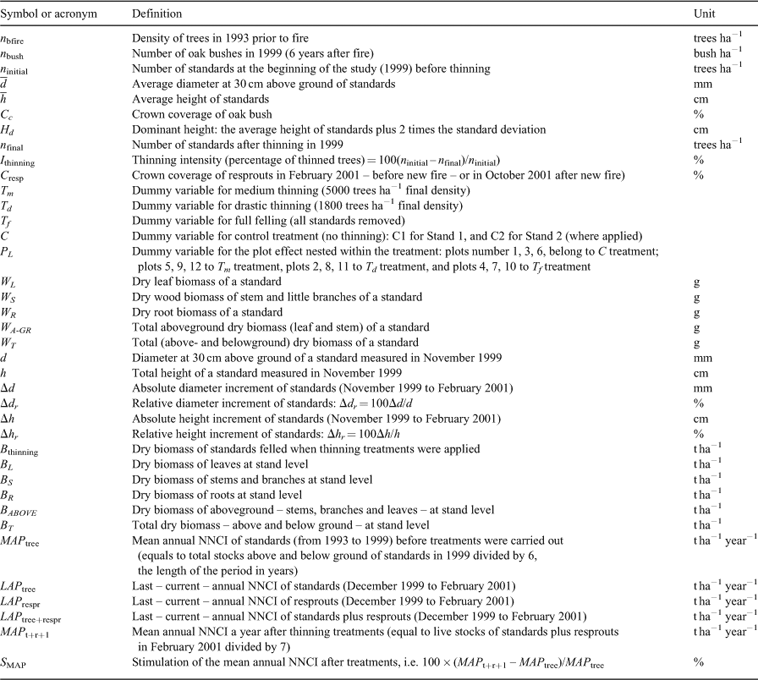Is the net new carbon increment of coppice forest stands of Quercus ilex ssp. ballota affected by post‐fire thinning treatments and recurrent fires?
Francisco R. López‐Serrano A D , Jorge De Las Heras B , Daniel Moya A , Francisco A. García‐Morote A and Eva Rubio CA Departamento de Ciencia y Tecnología Agroforestal y Genética, Escuela Técnica Superior de Ingenieros Agrónomos, Universidad de Castilla‐La Mancha, Campus Universitario s/n, E‐02071 Albacete, Spain.
B Departamento de Producción Vegetal y Tecnología Agraria, Escuela Técnica Superior de Ingenieros Agrónomos, Universidad de Castilla‐La Mancha, Campus Universitario s/n, E‐02071 Albacete, Spain.
C Instituto de Desarrollo Regional, Universidad de Castilla‐La Mancha, Campus Universitario s/n, E‐02071 Albacete, Spain.
D Corresponding author. Email: fco.lopez@uclm.es
International Journal of Wildland Fire 19(5) 637-648 https://doi.org/10.1071/WF08180
Submitted: 23 October 2008 Accepted: 6 November 2009 Published: 9 August 2010
Abstract
Coppice forest stands of Quercus ilex have been one of the forest types most impacted by fire in Spain. After fire, their capability to resprout produces a high density of stems that requires thinning in order to avoid stagnation within the stands. In August 1993 and July 2001, two consecutive fires affected a Quercus ilex coppice stand in SE Spain. This study investigated the effects of different post‐fire thinning treatments and recurrent fires on stock and net new carbon increment (NNCI) in a 6‐year‐old coppice stand. Four degrees of thinning were applied: medium thinning (to a final density of 5000 trees ha–1), drastic thinning (to 1800 trees ha–1), full felling (all trees removed) and no thinning (control). Results showed NNCI was within the lower limit of the average global values reported for net primary productivity of terrestrial ecosystems. The best thinning treatment to maximise both current annual NNCI and mean annual NNCI stimulation, and keep new resprouting within reasonable levels was medium thinning. However, recurrent fires caused the observed net primary productivity to decrease, which allowed us to conclude that stump vitality is affected by successive fires, at least the first year after a new fire.
Additional keywords: allometric relationships, biomass, carbon sink, growth, stocks.
Acknowledgements
We thank the Regional Forestry Service of Castilla‐La Mancha for providing the research site. We are grateful to the following people for field data collection: M. Valcárcel, J. Herreros, P. Iniesta and R. Miñano, and to Stefanie Kroll for revising the English version. This research was supported through funds provided by the Regional Plan of Scientific Research, Technological Development and Innovation of Castilla‐La Mancha (PBC‐05–013–2, PRINCET, 2005–2007).
Albaugh TJ, Allen HL , Kress LW (2006) Root and stem partitioning of Pinus taeda. Trees 20, 176–185.
| Crossref | GoogleScholarGoogle Scholar |
Bergez JE, Cabanettes A, Auclair D , Bedeneau M (1990) Effet des reserves de taillis sous futaie sur la croissance du taillis. Étude preliminaire. Annals of Forest Science 47, 149–160.
| Crossref | GoogleScholarGoogle Scholar |
Ducrey M , Toth J (1992) Effect of cleaning and thinning on height growth and girth increment in holm oak coppices (Quercus ilex). Vegetatio 99–100, 365–376.
| Crossref | GoogleScholarGoogle Scholar |
González‐Ochoa AI, López‐Serrano FR , de las Heras J (2004) Does post‐fire forest management increase tree growth and cone production in Pinus halepensis? Forest Ecology and Management 188, 235–247.
| Crossref | GoogleScholarGoogle Scholar |
Kruger EL , Reich PB (1997) Response of hardwood regeneration to fire in mesic forest openings. II. Leaf gas exchange, nitrogen concentration and water status. Canadian Journal of Forest Research 27, 1832–1840.
| Crossref | GoogleScholarGoogle Scholar |
Melillo JM, McGurie AD, Kicklighter DW, Moore B, Vorosmarty CJ , Schloss AL (1993) Global climate change and terrestrial net primary production. Nature 363, 234–240.
| Crossref | GoogleScholarGoogle Scholar | CAS |
Ne’eman G, Lahav H , Izhaki I (1995) Recovery in a natural east Mediterranean pine forest on Mount Carmel, Israel, as affected by management strategies. Forest Ecology and Management 75, 17–26.
| Crossref | GoogleScholarGoogle Scholar |
Parresol BR (1999) Assessing tree and stand biomass: a review with examples and critical comparisons. Forest Science 45, 573–593.
Sabaté S, Gracia C , Sánchez A (2002) Likely effects of climate change on growth of Quercus ilex, Pinus halepensis, Pinus pinaster, Pinus sylvestris and Fagus sylvatica forests in the Mediterranean region. Forest Ecology and Management 162, 23–37.
| Crossref | GoogleScholarGoogle Scholar |
Serrada R, Allue M , San Miguel A (1992) The coppice system in Spain. Current situation, state of art and major areas to be investigated. Annale delĺIstituto Sperimentale per la Selvicoltura 12, 266–275.
Sprugel DG (1983) Correcting for bias in log‐transformed allometric equations. Ecology 64, 209–210.
| Crossref | GoogleScholarGoogle Scholar |
Vallet P, Dhôte JF, Le Moguédec G, Ravart M , Pignard G (2006) Development of total aboveground volume equations for seven important forest tree species in France. Forest Ecology and Management 229, 98–110.
| Crossref | GoogleScholarGoogle Scholar |

|


